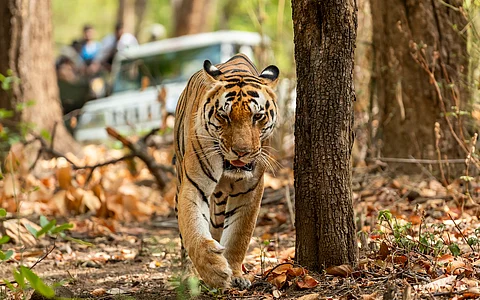

Experts are concerned about the increasing human-tiger conflicts in India, attributing the change in tiger behavior to factors like habitat loss and human proximity.
With 35% of tigers living outside protected areas, their dependency on livestock has grown, leading to more interactions with humans and potential attacks.
This is the third of a 5-part series. Read the first, second, fourth and fifth parts
Increasing human-tiger conflict has become a concern in recent years in India. But experts say there are multiple factors that have led to a change in animal behaviour, which might be causing these encounters.
Carnivore biologist Abhishek Harihar said tigers’ first preference other than their natural prey will always be cattle, which are similar to gaur and wild buffalo. “In general, tigers are not known to prey on primates,” he added.
But tigers increasingly living in proximity to humans and rising interactions between both may be making people more vulnerable to tiger attacks.
A study published in the journal Science in January this year noted that about 45 per cent of tiger range spread across 20 Indian states is also home to 60 million people. The study also noted that over the past two decades, tiger occupancy in India increased by 30 per cent, increasing its range by nearly 138,200 square kilometres.
As per the All India Tiger Estimation 2022 report, nearly 35 per cent or 1,289 of the estimated 3,167 tigers in the country are living outside protected areas.
M K Ranjitsinh, architect of the Wild Life (Protection) Act, 1972, said even as tiger numbers have increased, their prey animal populations have not risen proportionally. This has made them more dependent on livestock, thereby bringing them in more proximity with humans.
“Tigers have also lost not just fear but also all regard and respect for human beings. One hundred and fifty years ago, humans were common prey for them. But with instances of hunting and mob chasing, tigers stayed away from humans,” he said adding, what one sees in the wild is not a tiger but a caricature of a tiger. The way a tiger is pursued in protected areas and goes weaving in and out of jeeps is not its natural behaviour, according to Ranjitsinh.
Rahul Shukla, former wildlife warden of Kishanpur/Dudhwa National Park who has extensively studied tigers colonising sugarcane farms in Uttar Pradesh’s Terai, said, “The rise in village populations near forest areas have helped increase familiarity of tigers with humans. Tiger sightings have become common in villages bordering forest areas.”
Territorial fights often push tigers away from forest areas, compelling them to search for safer habitats such as sugarcane farms, he added.
Imran Siddiqui, senior field conservationist at the Centre for Wildlife Studies (CWS), said high site fecundity exacerbates human-tiger conflicts. The growing tiger population, driven by successful breeding, results in more tigers competing for limited space and prey.
“This forces them into human-dominated areas, increasing attacks. For instance, 150 of 173 wildlife-related deaths in Chandrapur between 2021 and May 2025 were due to tigers, with 53 fatalities in 2022 alone,” he added.
Citing an example of tiger attacks in the Chandrapur forest area, he said in 2006, the tigers were reported to be about 30-40. This figure has now increased to more than 250. “These attacks can be attributed to behavioural adaption, overcrowding, habitat loss and human activity,” he explained.
Leading tiger expert K Ullas Karanth said such changes can be termed ‘behavioural’ and not evolutionary. “For the welfare of tigers and humans at a wider scale, tigers should be afraid of human beings on foot. But that has changed,” he said.
According to Karanth, “saving” every tiger, “rescuing cubs, injured or old tigers” and “tranquillising and caring” for tigers which have preyed on humans instead of swiftly killing these individuals are utterly counter-productive to the rational management of the species. The wholesale conflation of “animal welfare” with “wildlife species conservation” by the public, so-called animal lovers and even wildlife managers is what needs to change, he said.
Such care has changed the perception of tigers towards humans.
Siddiqui said the rise in attacks reflects short-term behavioural adjustments to environmental and social factors. Habitats should not be augmented with water or prey for tiger conservation, he added.